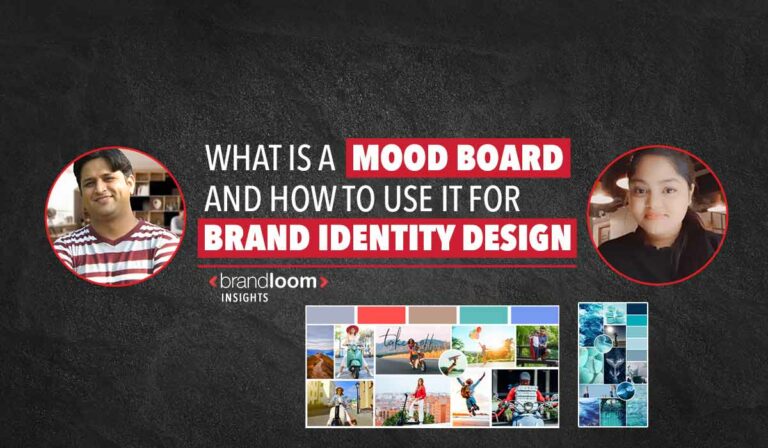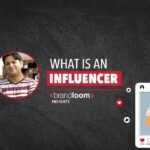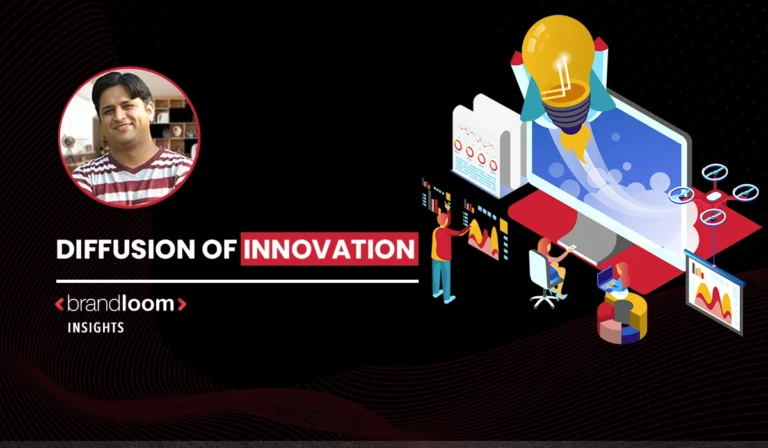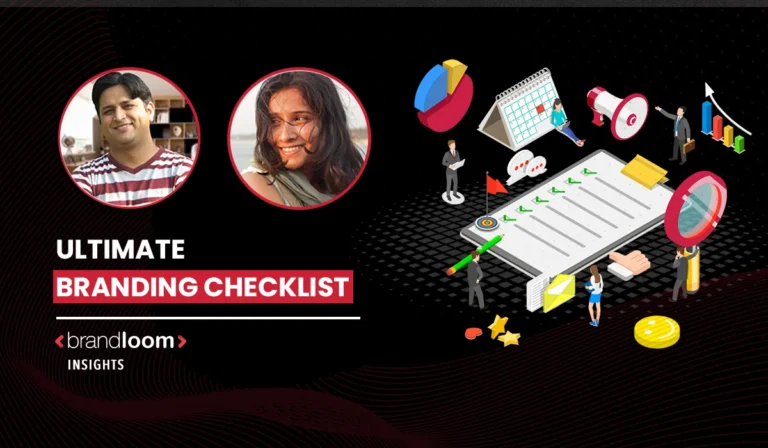The saying goes that a picture can convey a thousand words.
When you want to give a brand a distinct visual identity- you may find that words often fail to capture what you want to depict. This is where designers depend on Mood Boards.
A mood board is a tool that can help you communicate the vision, personality and look & feel of the brand via arresting imagery effectively.
This is why they are a brand designer’s BFF. In this article, we will look at what a mood board is and how to use it for brand identity design.
If you are looking for good designers who can do your brand justice and bring to life the vision you have for it- talk to the BrandLoom team. Our designers and brand planners can create the perfect visual identity for your brand that will help you resonate with your target audience and stand out from your competitors.
Now- let us look at mood boards and understand how you can deploy them in a brand design project.
What is a mood board? Mood board meaning
A mood board is a collection of materials and images that illustrate the concepts and ideas behind your upcoming design project. Mood boards are used by graphic designers to convey the look and feel visually – or atmosphere they intend to create for their clients.
Mood board examples
1. A fashion mood board
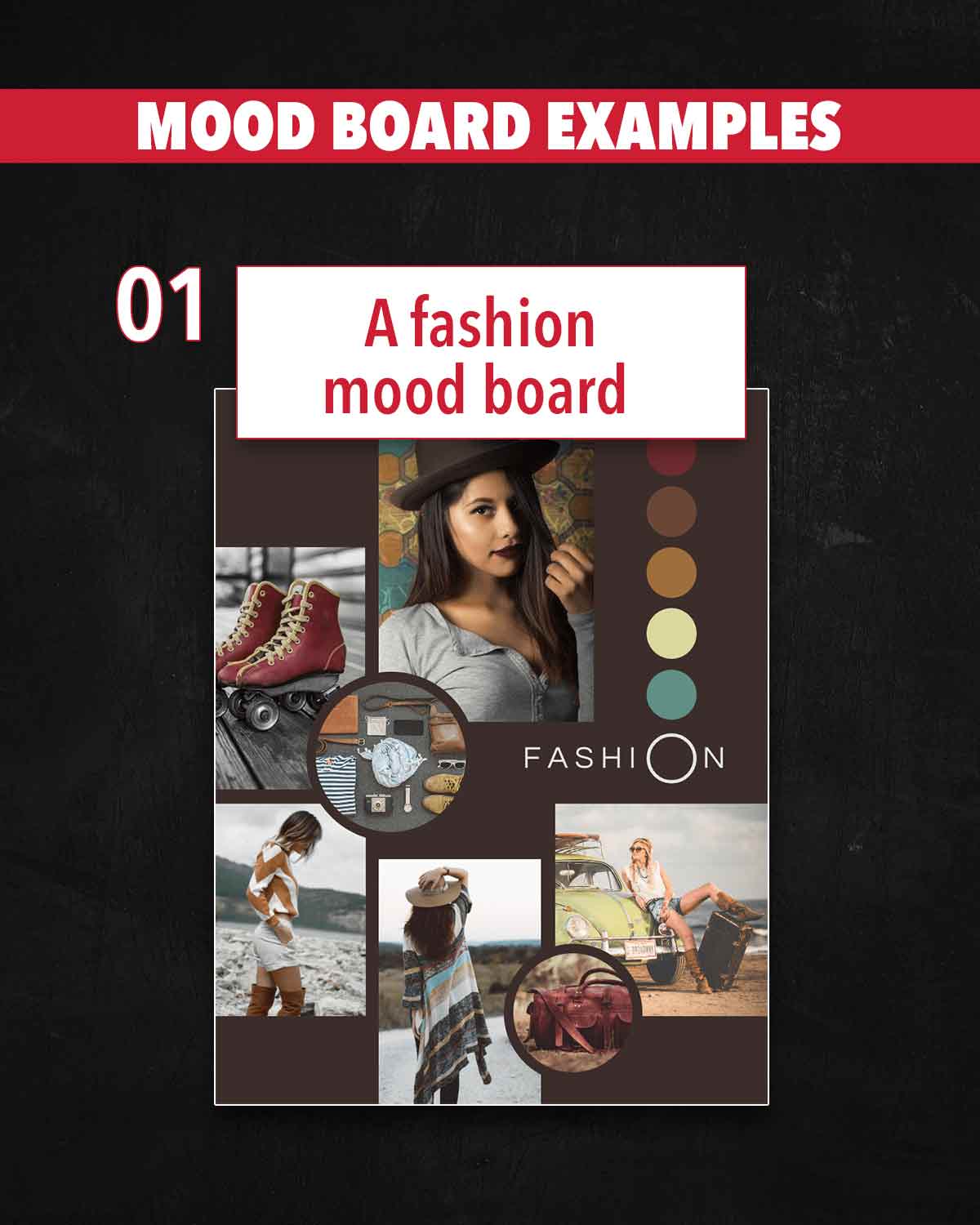
2. An interior design mood board
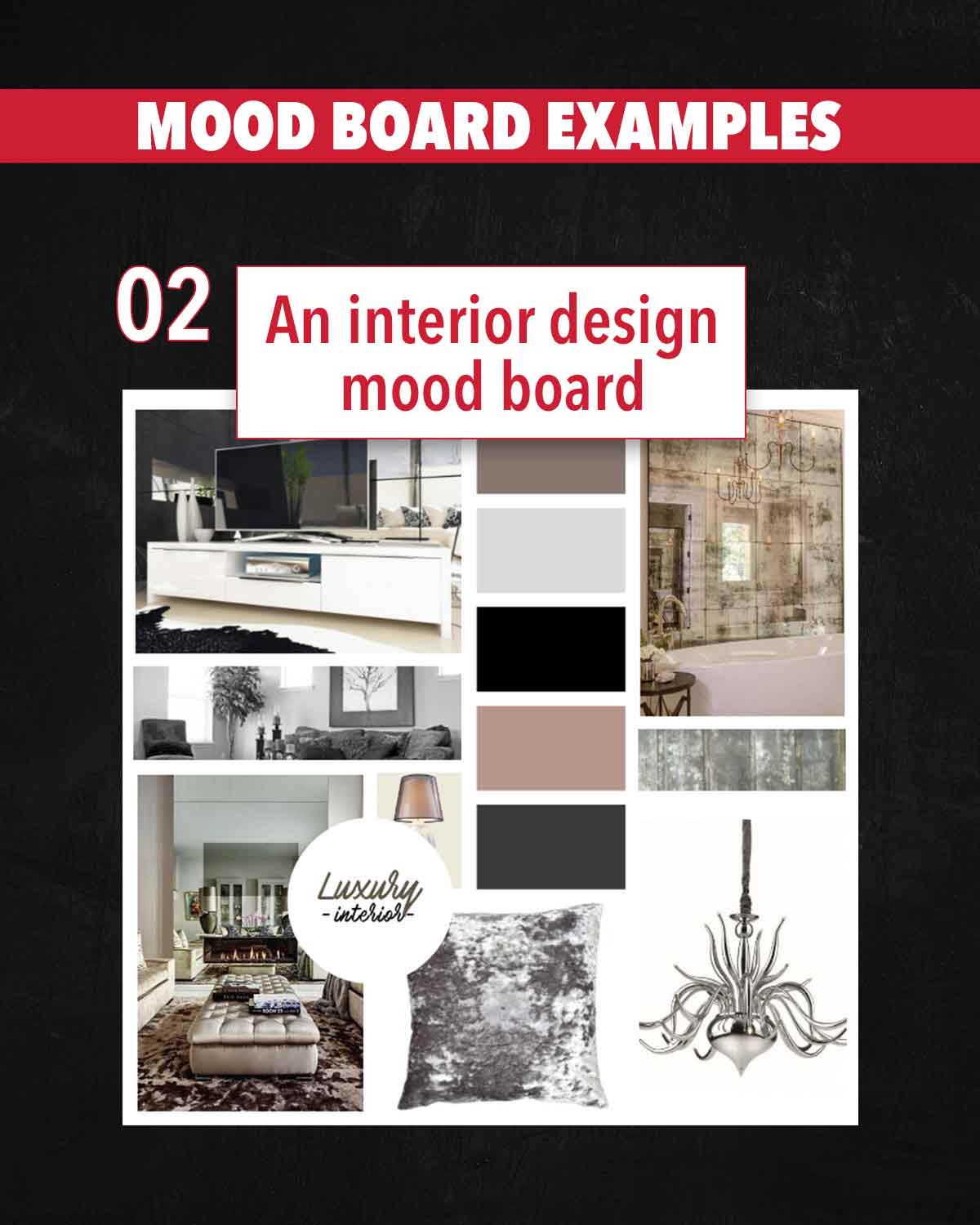
Benefits of making brand mood boards
Here is why you should make mood boards a part of your design process.
1. Can give the sense of a brand’s visual identity and personality
Mood boards help designers tap into their creative side by using visual cues to see how they can blend different concepts, inspirations and moods in a coherent way. They help designers understand the client’s taste in design and deliver a project in line with their expectations.
Mood boards are helpful for designing websites, logos and print materials such as greeting cards, posters, invitations, book covers, and social media graphics.
2. Serve as inspiration
Mood boards can inspire the designing team to come up with ideas that resonate with the feel of the brand or campaign. When doing this, it is vital to remember that mood boards should not be taken as a literal representation of the final design.
3. Stimulate creativity
Mood boards can also help designers develop fresh and creative ideas for projects. This is because mood boards vary depending on the designer’s interpretation of their feelings about a specific design/brand.
4. Serve as a foundation
They make for good reference points to come back to when you think of evolving/refining your brand or approach. Mood boards work well as a foundation to build upon because they have been carefully crafted to give a general idea of what the designer is going for.
Using mood boards also helps the team save time by focusing on creating what matters and not getting stuck trying to develop ideas from scratch.
5. Serve as a communication tool
Mood boards are very versatile and can help create cohesive communication across departments.
6. Give an idea about the end-product
Mood boards are also helpful when trying to visualize a potential end-product. For example, you might be working on a fashion line, but the mood board helps envision how it will look (with dresses, shoes, bags, etc.).
Example of a mood board created for a sample campaign
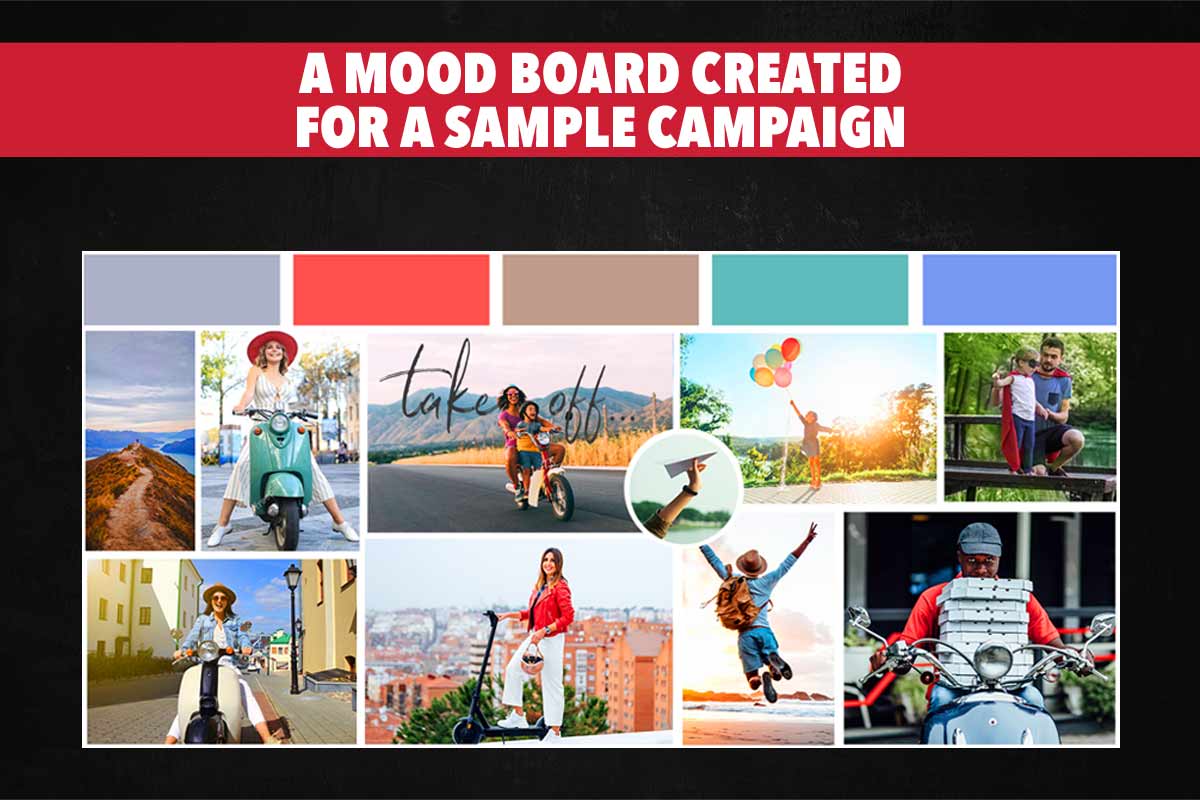
How to create a mood board: Bringing your mood board ideas to life
Here is a step-by-step guide and some pro tips for creating a mood board.
1. Agree on the approach
Talk to the client and your team to have a uniform vision for the brand. Get to know the target audience and understand what mood the brand wants to invoke.
2. Understand the central message
What is the brand or the campaign trying to say? Think of the action you want the target audience to take, and then think of what visual cues can help them get in that headspace.
3. Identify the critical elements for the best mood board design
The best mood boards have a consistent colour palette and identity, which should reflect in all visuals. This will give your team a good starting point for creating the right content.
4. Create a Pinterest mood board/ sample board to collaborate with your team
If you don’t want to display items on paper, create a Pinterest board as it’s easier for your team to play around with images.
5. Add a personal touch
If you are presenting mood boards to clients, make sure each theme has its board, and the items on them reflect your unique style. This will help your client understand your vision for their brand or campaign better.
6. Gather the mood board images, textures, and words to put on it
Start with images, as they are the base of any mood board. Use free stock photos sources. You can use sites that offer wallpapers for your phone or computer for textures.
7. Compose the mood board
Now start laying the materials out. Pick and choose what works and what doesn’t. Try turning images upside down and sideways to see if they have a different feel. Keep playing with the arrangement until you find one that feels right.
8. Written explanation/ Inspiration
To finish off your mood board, add in any written inspiration or concepts that inspire you to explore a particular direction for a project. If the central message or the concept needs to be explained, do it concisely. You can also include keywords in the written part.
Mood boards used to create advertisements or marketing campaigns require a lot more detail than general mood boards, but the process may remain unchanged.
Complex brand design processes should be left to the experts. If it feels overwhelming for you to get into the designing process- leave it to expert agencies with a proven track record like BrandLoom. We can help you realize your vision with panache.
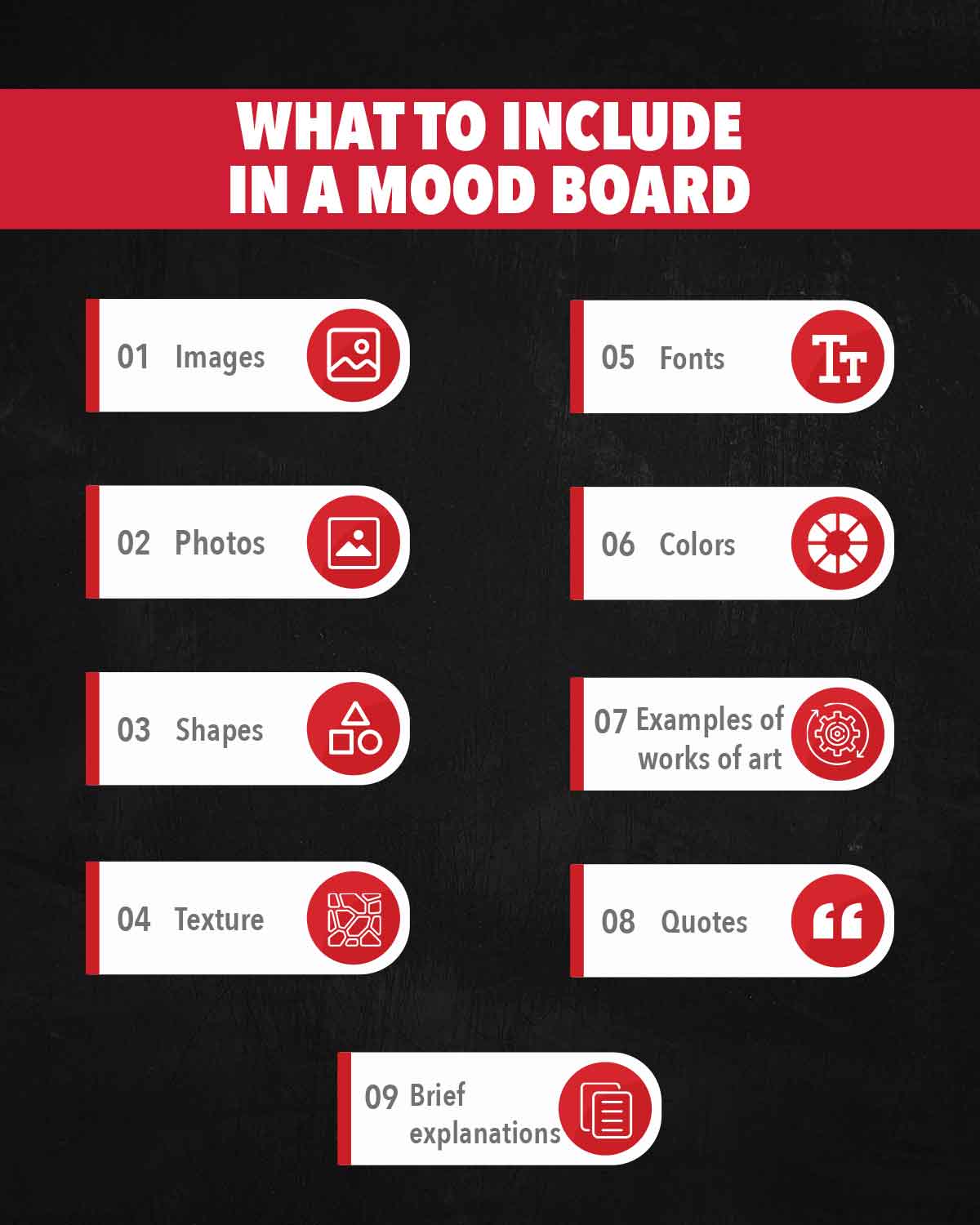
- Images that seem to speak to your concept. These could be images of people, places, things or even a combination of all three.
- Photos of architecture and interior design that you’re drawn towards.
- Animals and plants, and images from different countries or cultures can help broaden your design vernacular.
- Shapes. Not many designers include different shapes in mood boards- but they should. Geometric shapes play a big part in any design, and it will be good to see what forms resonate with your vision.
- Designs from particular eras, new or old that are inspirational to you.
- You can find colour inspiration by looking at anything from nature and man-made creations.
- Textures in all forms – clothing, wood, leather, paper, etc.
- Fonts. Draw inspiration from your favourite fonts for all of the different elements of your logo design. Many designers have a separate mood board for fonts.
- You could also consider the symbolism of colour, animals and objects, and shapes for more abstract concepts.
- Examples of works of art. Use images/ words created by artists to inspire your designs.
- Lists of words/phrases inspiring to you, both emotionally and aesthetically.
Digital mood board creators: Tools for creating mood boards
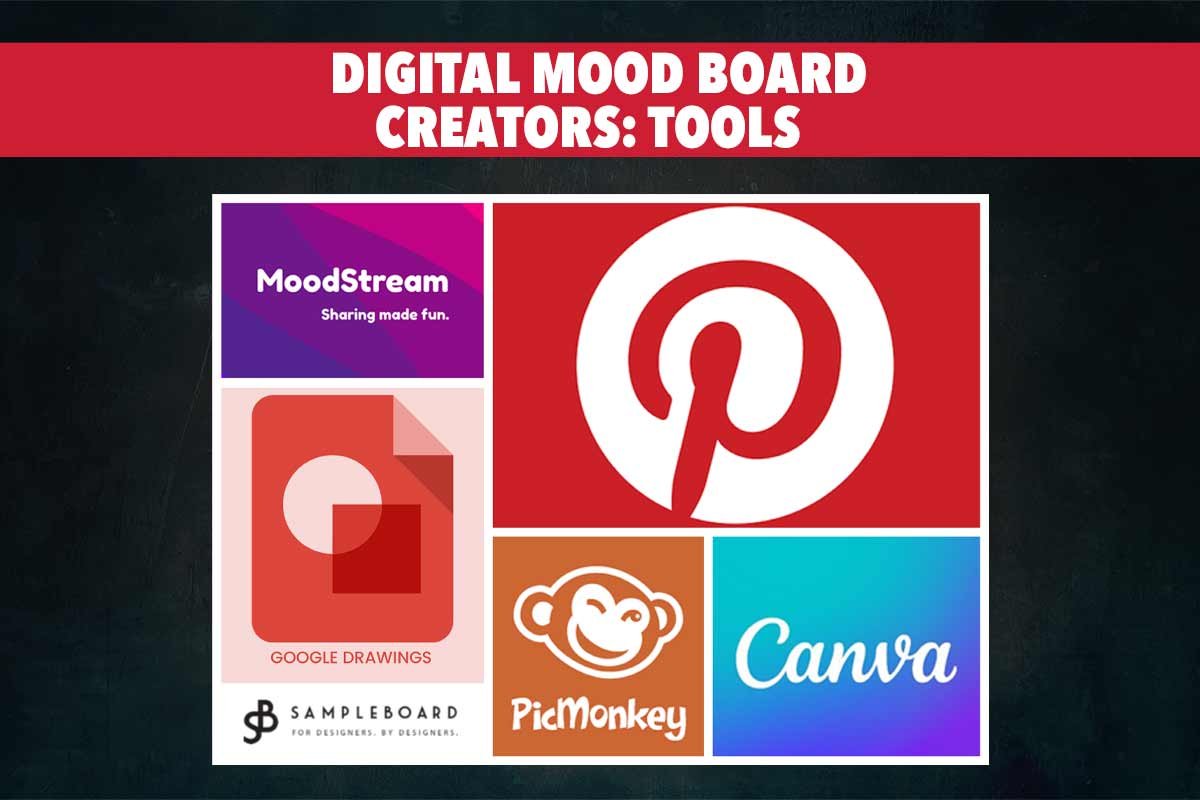
1. Pinterest
This app lets you curate images and pin them to create a collage or collection. Pinterest mood boards are handy because other users have already started their own pins and boards- you can browse through them for inspiration and collect what speaks to you.
2. Midstream
A tool by Getty allows you to upload your images, and it creates a visual representation of the many moods of an image collection.
3. Sample board
This intuitive tool lets you upload and organize your images into files that you can share on social media.
4. Canva
Canva has many mood board templates for quick and easy use. It also has many inbuilt fonts, images and design elements to create collages and mood boards.
5. Picmonkey
This free tool lets you add text, embellishments, and effects to your images.
6. Google Drawings
A free online drawing tool with preset mood template boards that allow you to add content from search queries or your drive or email account.
Benefits of creating inspiration mood boards
Here are some pros of using a mood board in the design process.
- A digital mood board is a great way to convey your vision for their brand to the client. It gives the client a good feel for how you’re visualizing their brand. It shows your client that you’ve put some thought into their application, and it can help them get excited about the prospect of working together.
- Both clients and designers can get an idea of what the finished product will look like before investing too much time into the project.
- Mood boards are also good inspiration for both designers and clients. They often give you new ideas for projects before they even begin!
- They help create consistency across your portfolio. Mood boards can give your work a cohesive feel and add an extra dimension to your designs.
- They’re fantastic for branding. Mood boards help convey the feeling of your client’s brand by using other brands, colors and art that you think they will approve of.
How mood boards make the designing process easier
- It is easier, more affordable and less time-consuming to make changes in the mood board before you start creating demos or prototypes.
- There will be fewer revisions on the finished designs as the mood board represents the already agreed-upon vision of the client.
- It is easier for designers to keep track of mood board revisions as fewer sketches, wireframes, and mockups are involved.
- Mood boards simplify the presentation process by helping you design a document that presents all your ideas on one page at once. It provides an overview of the project before it has started. Thus, giving you a better overview of the project and helping to communicate your ideas with the client.
- Mood boards simplify the feedback-handling process. You can collect all comments and changes on one document, which is easier for you and your clients to discuss and, more importantly, implement without losing any information along the way.
Conclusion
Mood boards are an essential part of the designing process, as they help designers create a cohesive visual style for any project. They let you convey an idea for a project before it has even started. Mood boards are especially useful in the branding process, as they give your client an idea of what their brand will look like with you as their designer.
If you want to create a unique visual identity for any brand- or any campaign, incorporating mood boards in the process will improve it. If you want to create a strong brand identity, business owners trust the job to the experts at BrandLoom. Our designers and brand planners can help you carve a distinct niche in the market and become the go-to brand for your target audiences.
FAQs
What is the purpose of a mood board?
The purpose of a mood board is to create an idea about your project’s direction. It’s essentially throwing key images into a folder together with some texts or video clips, then arranging it all on the wall in one giant collage. The process of collecting material onto boards can help you share your view of what is important now and is an integral part of the research process.
What is a mood board?
Moodboards as a starting point for design work can be extremely helpful. They simplify the complex and make it more cohesive by highlighting core concepts and establishing a base that will later support various creative decisions. Mood boards are usually assembled during the early stages of creating visual art or digital media, but you can also use them in other processes such as writing.
How do you make a mood board?
Start collecting images related to what you are working on right now, but don’t limit yourself just to those. Add anything that comes to your mind and makes you feel certain emotions or memories – this is all about feelings and your visualization of a particular thing or colour. This is important because this will help you later on to have a clear vision of what mood you want to convey with your project.
If it’s related to the brand/company design – try searching for logos and fonts similar to those you’re planning on using down the road; add the colour you would like to use for your project and some images that represent your brand/company. Maybe even try to mock up a few pages of the website or an app if that is what you’re working on right now.
If it’s about a web design – go wild with colours, shapes, fonts etc. You can also add some textures or mockup the layout of your future web page. Maybe even make it look like a presentation to have more structure on the board.What is included in a mood board?
A mood board includes images, textures, fonts, colours and concepts relevant to a design. You can also include quotes, images of works of art, or brief explanations of key concepts in it.
It can be created from various sources, such as images from magazines, stencils of streetscapes, photos taken on a camera or found during a Google search. A lot of time and effort might go into collecting these materials before starting a design project.

